In Tor de’ Cenci, in the southern suburbs of Rome, a brutalist-inspired apartment overlooking the Castelporziano Nature Reserve finds new breath thanks to the intervention of STUDIOTAMAT.
Architect’s design mixes different tones, moods and textures, in a harmonius and clean way, combining softness and brutalism at the same time. Custom-made details complete the project and gives a unique caracter, according to the young couple’s tastes and needs, that “wanted a bright, open house that privileged the uniqueness – sometimes even imperfect – of the materials” as they state.
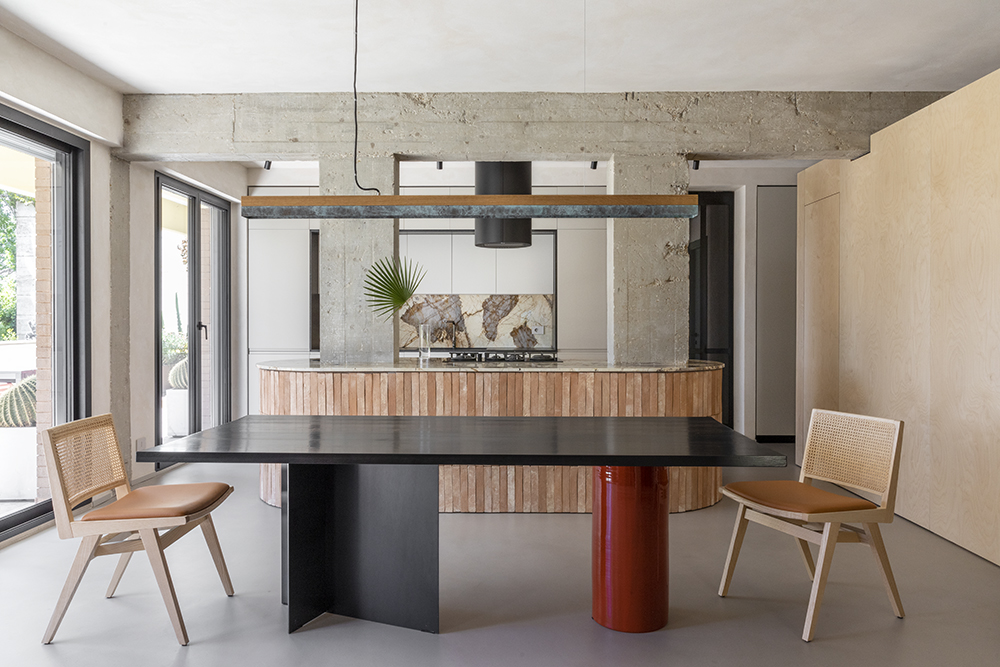 A renovation project with character, designed for a young couple of lawyers, which materializes in a 120 sqm house with large windows and a 40 sqm equipped terrace that captures the abundant natural light and let the gaze wander towards the greenery, up to the Roman coast:
A renovation project with character, designed for a young couple of lawyers, which materializes in a 120 sqm house with large windows and a 40 sqm equipped terrace that captures the abundant natural light and let the gaze wander towards the greenery, up to the Roman coast:
“We are originally from Sicily and felt the need to reconnect with nature, which is why we moved from the center to a more marginal area, surrounded by woods and not far from the sea. Since we moved to Rome we have always lived in small, cramped apartments with artificial materials. We wanted a bright, open house that privileged the uniqueness – sometimes even imperfect – of the materials” – the owners tell.
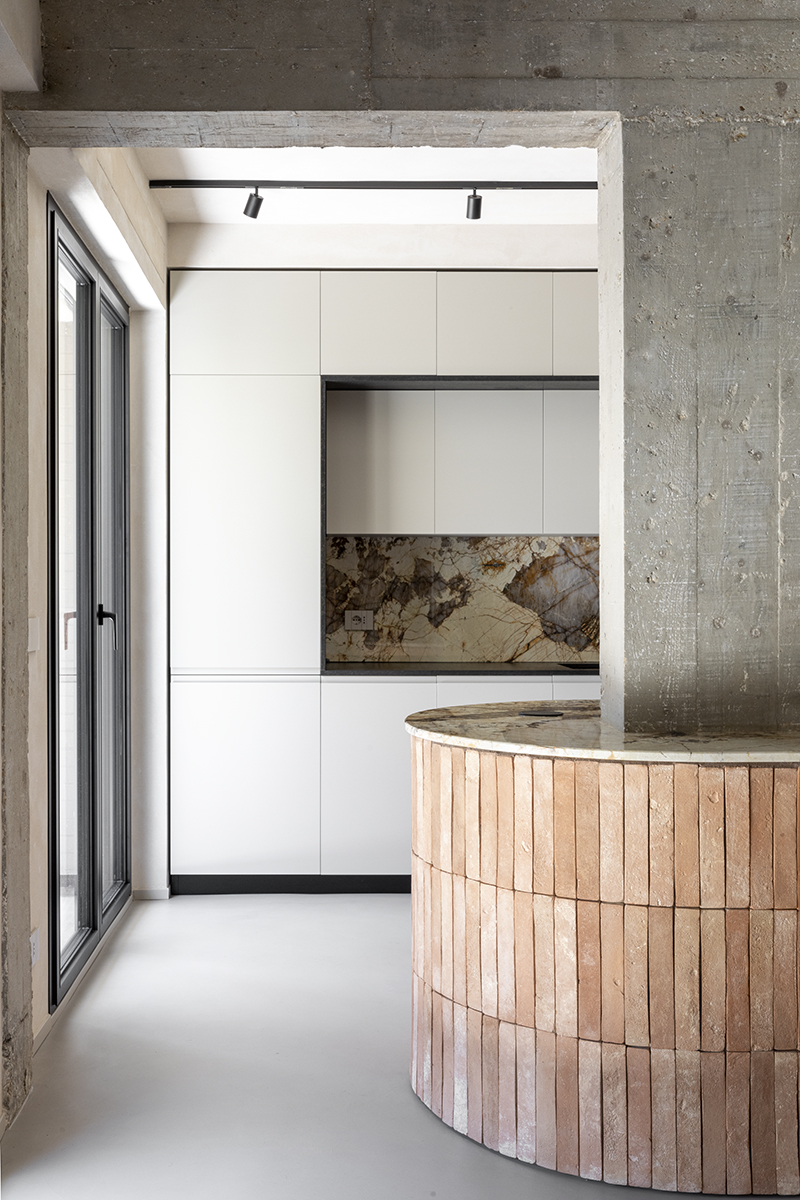
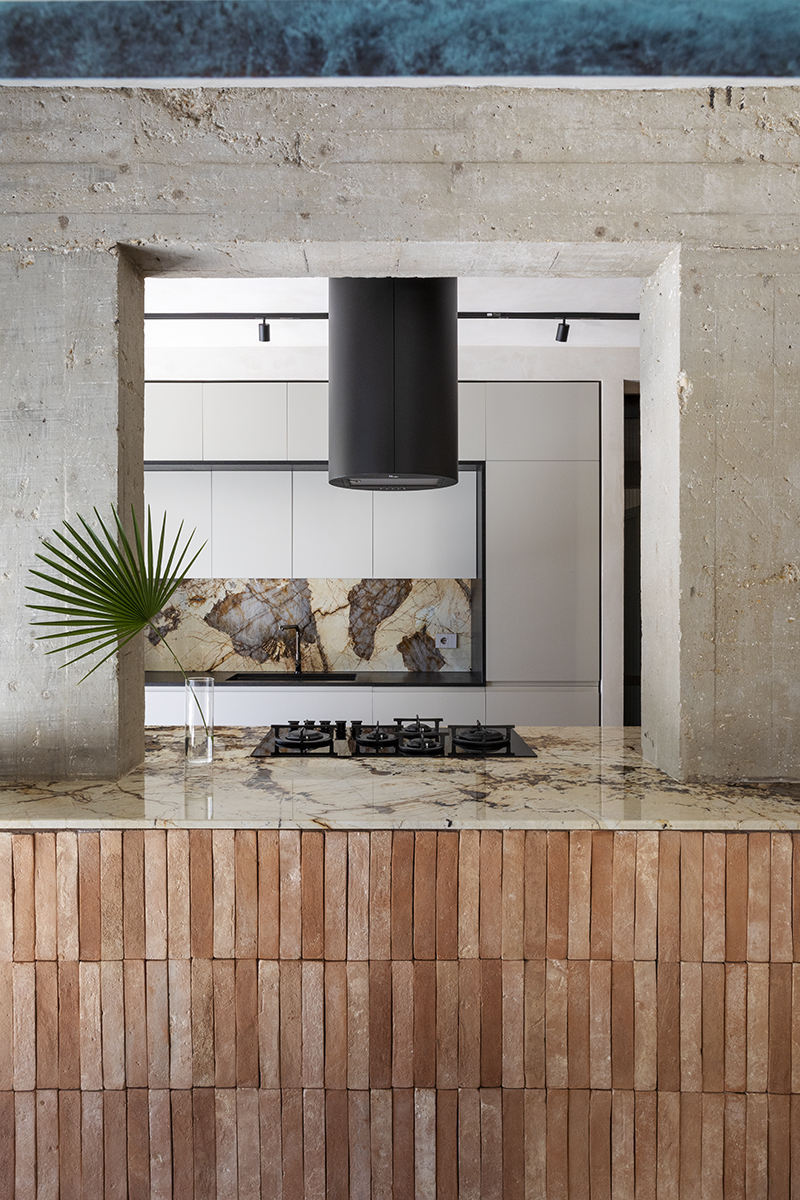
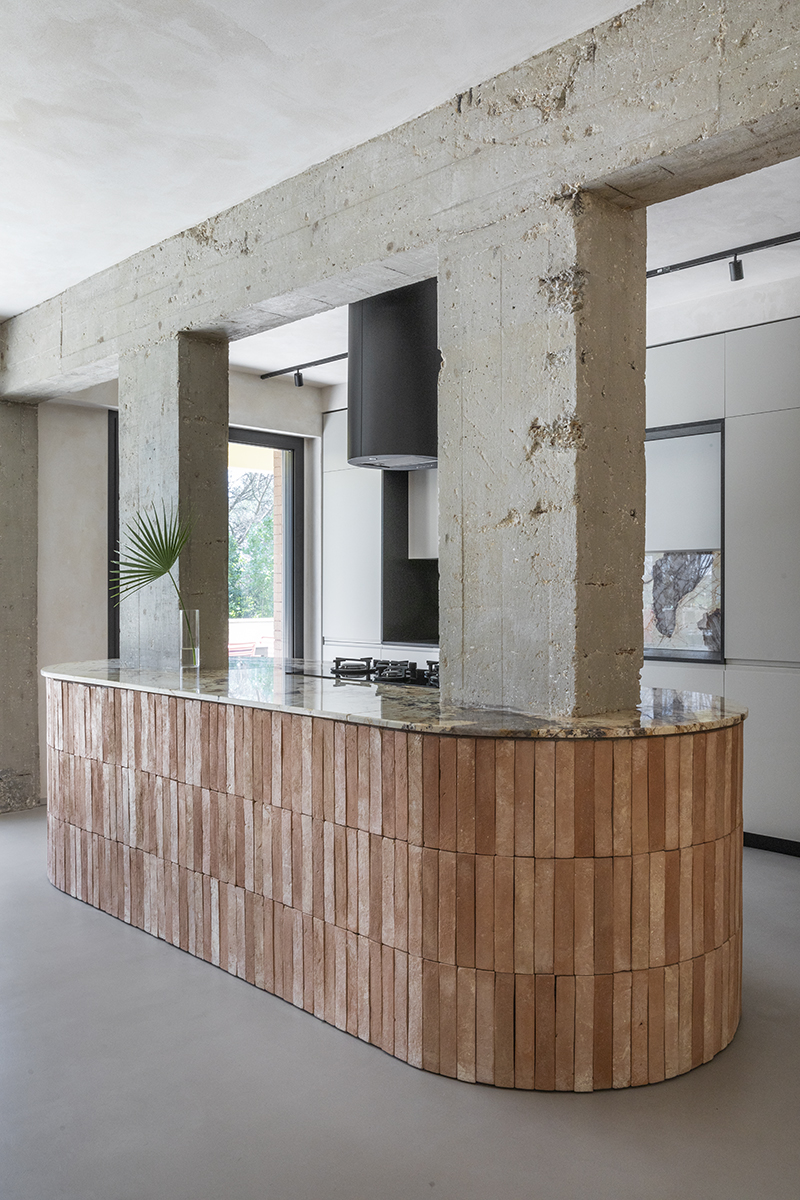
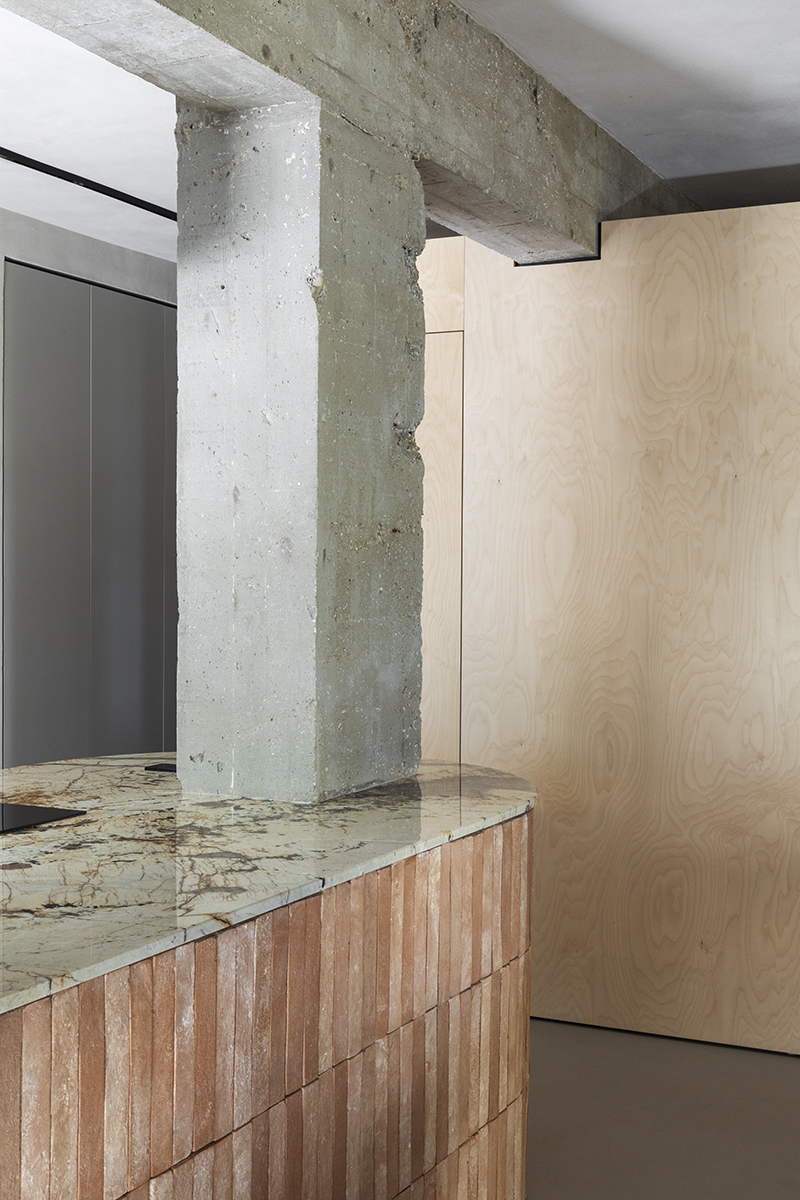
Casa Rude was born from these needs, so renamed for the sensual use of materials, such as the reinforced concrete left exposed and unshaved of the pillars and beams, which frame the rooms of the living area:
“What guided us in the design was the desire to enhance the distinctive features of the unique terraced building, dating back to the 1980s, which houses the apartment. We wanted to restore fluidity to the spaces, encourage the opening and the rediscovery of pre-existing materials and details, on which to set a new vision”
– explains Tommaso Amato, co-founder of STUDIOTAMAT.
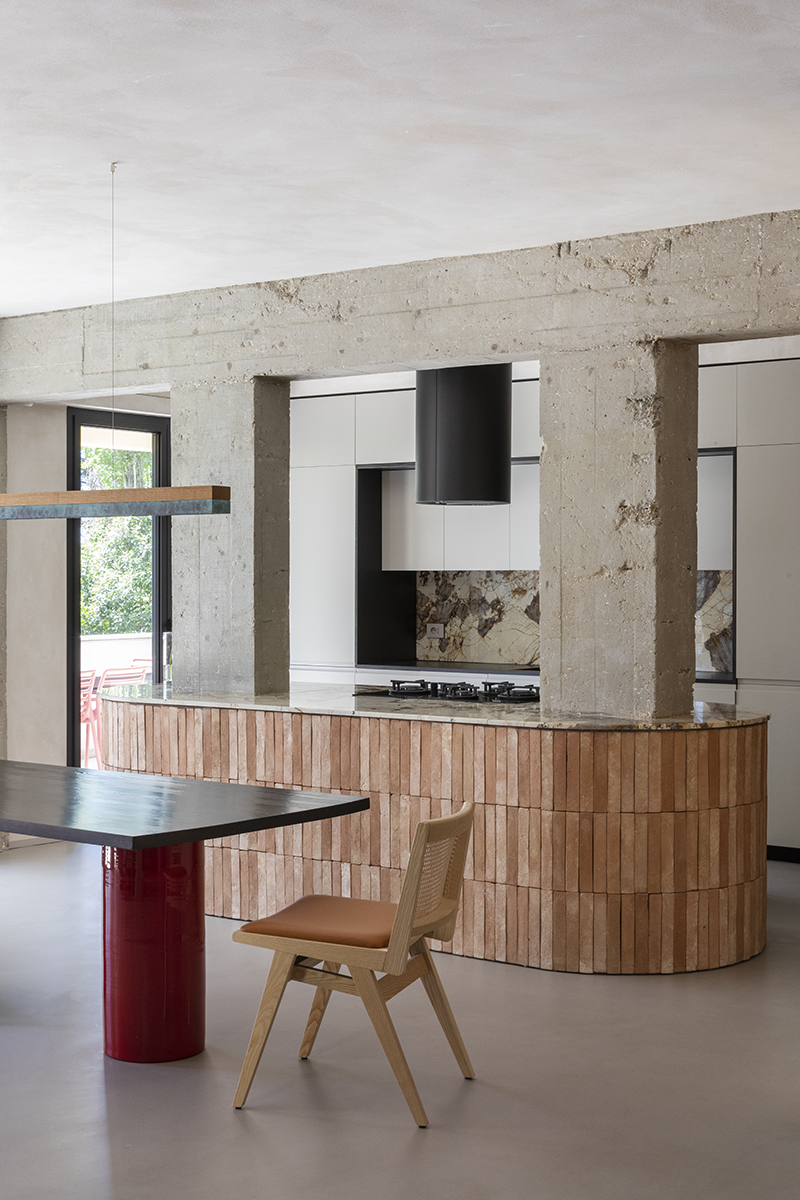
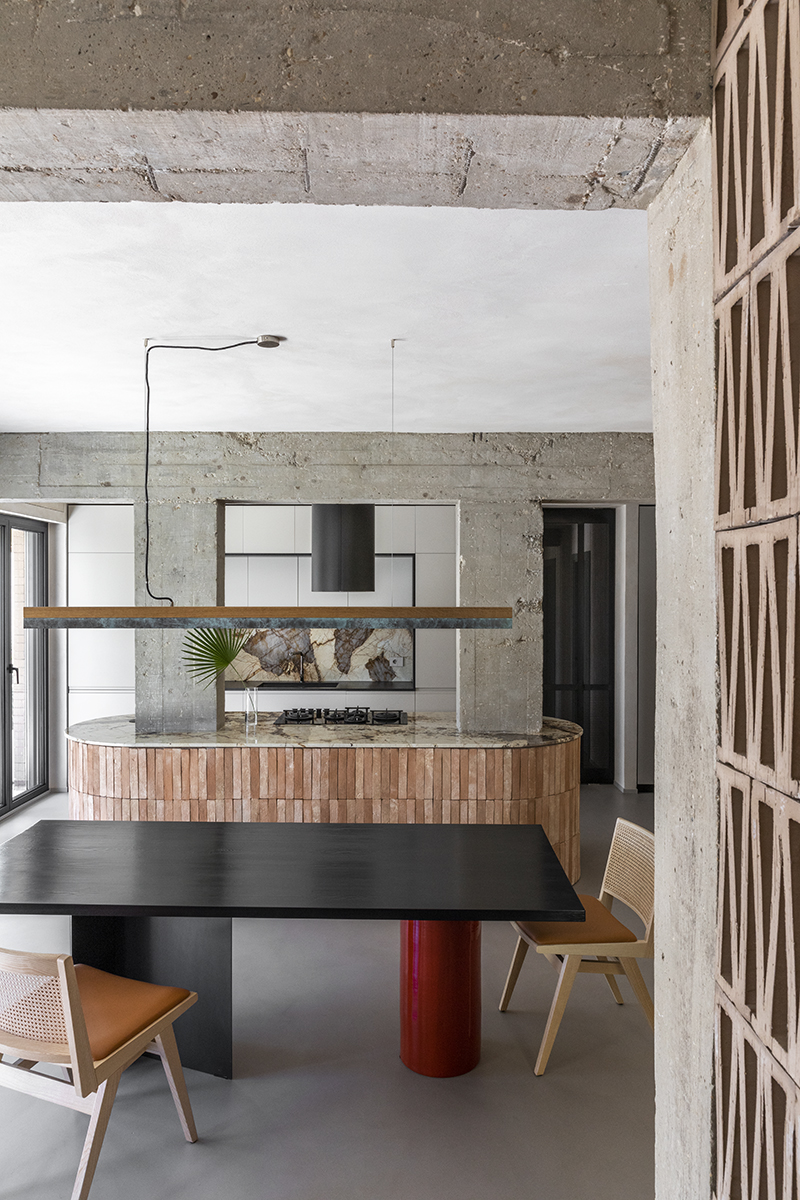 The studio harmoniously mixes different tones, moods and textures, stimulating the tactile experience of architecture. The clean and elegant lines balance the raw aspect of the coverings, such as the terracotta of the kitchen or the perforated brick wall, with a typically artisanal taste, which divides the living area from the study. The cement on the ground, based on natural hydraulic lime, has an elaborate texture that makes the space vibrate, while the walls and ceilings have been treated with a skim coat lightened with recycled glass microspheres, which makes the surfaces heterogeneous.
The studio harmoniously mixes different tones, moods and textures, stimulating the tactile experience of architecture. The clean and elegant lines balance the raw aspect of the coverings, such as the terracotta of the kitchen or the perforated brick wall, with a typically artisanal taste, which divides the living area from the study. The cement on the ground, based on natural hydraulic lime, has an elaborate texture that makes the space vibrate, while the walls and ceilings have been treated with a skim coat lightened with recycled glass microspheres, which makes the surfaces heterogeneous.
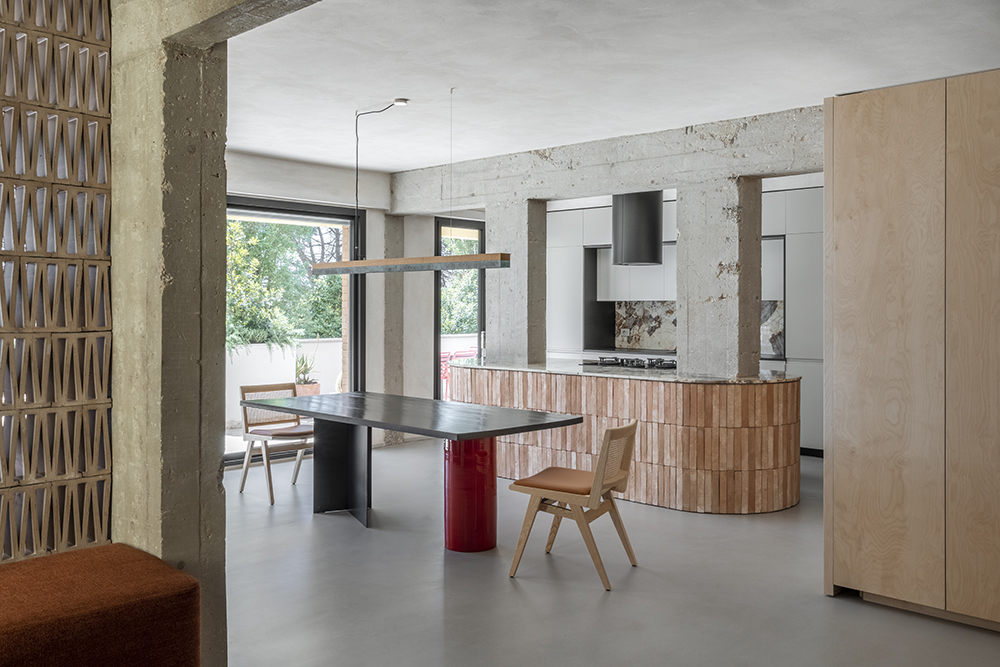
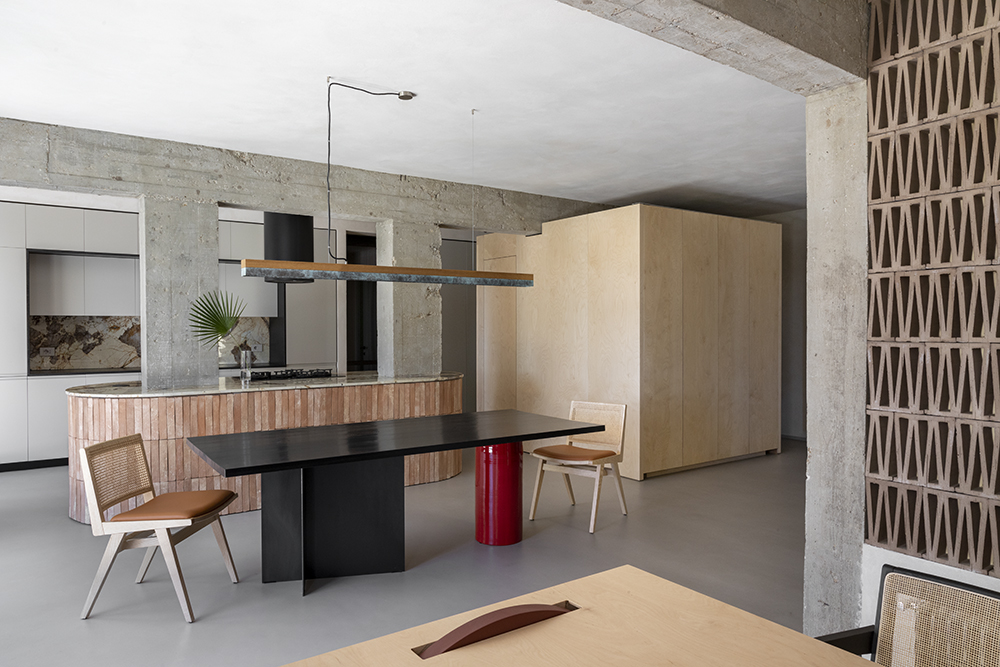
The living area is designed as a loft, a single space with unfinished walls and continuous flooring, which houses the entrance, living room, dining room and kitchen, visually connected by the supporting structure in exposed concrete. As a pivot, an imposing multifunctional cube in birch wood hides inside the pantry, a wardrobe for coats and a bookcase with TV.
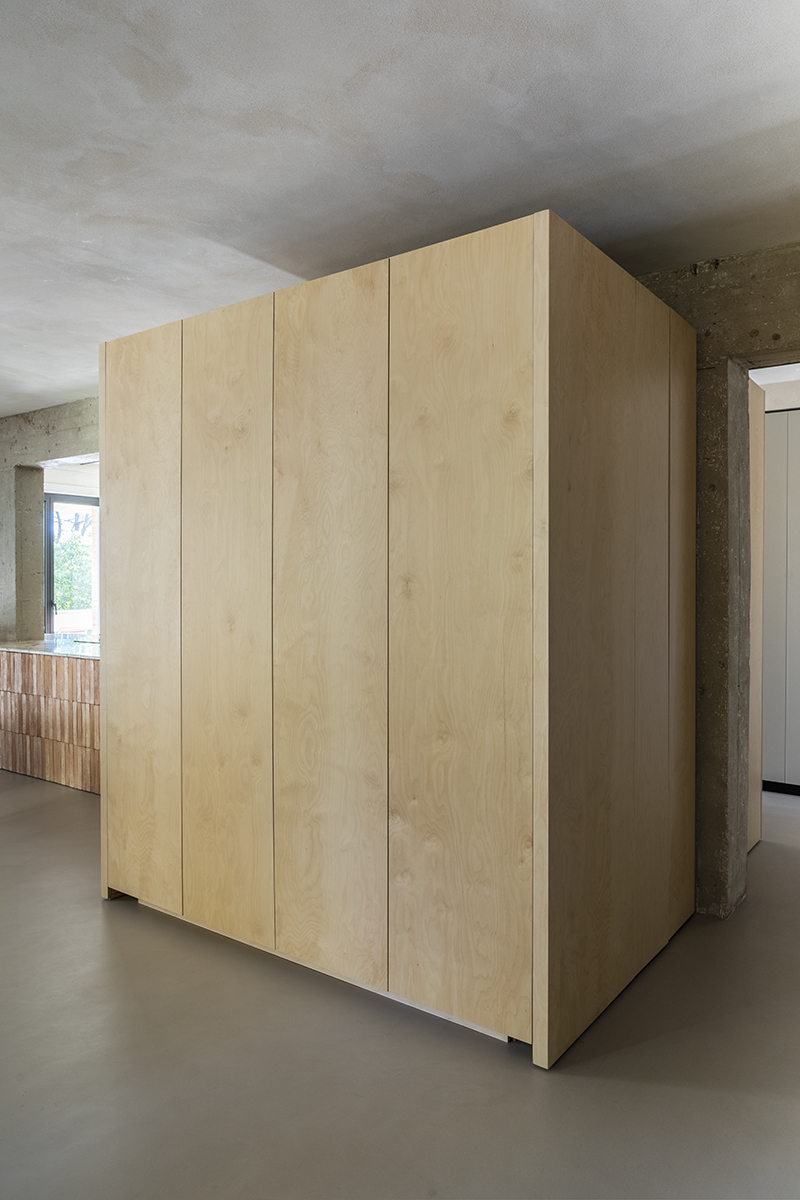
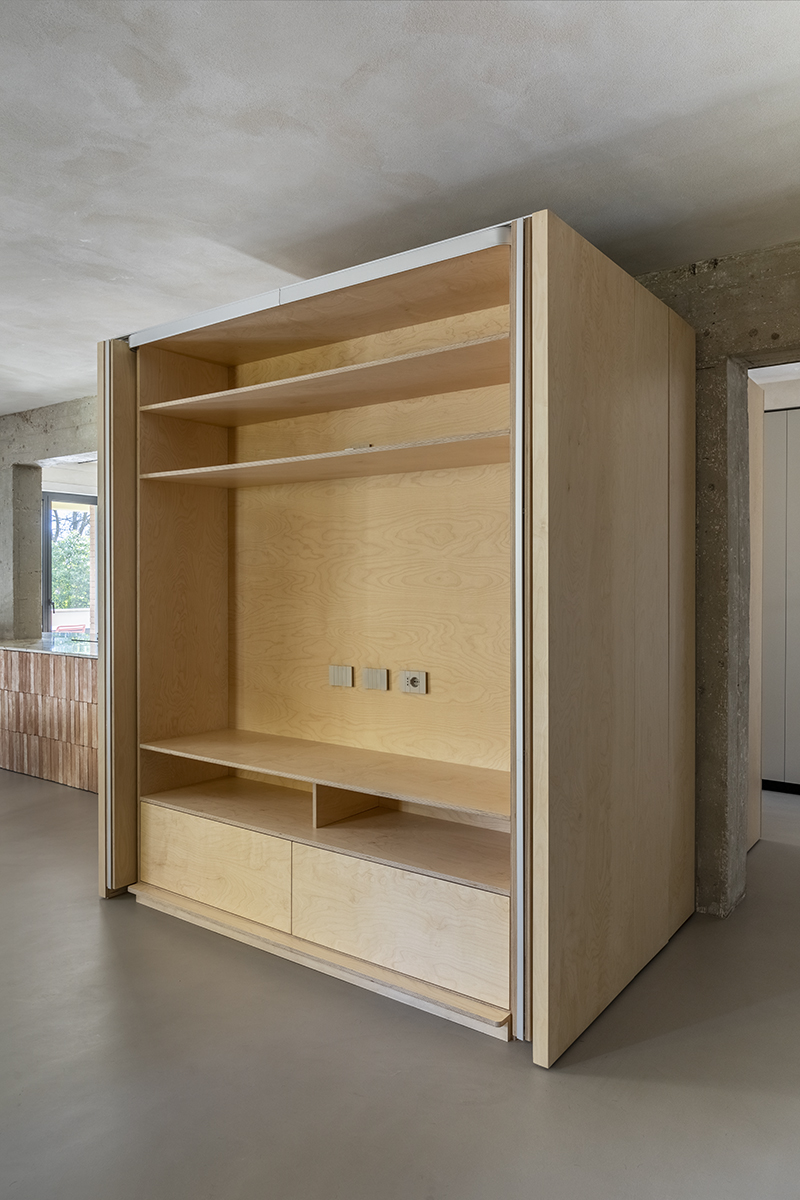
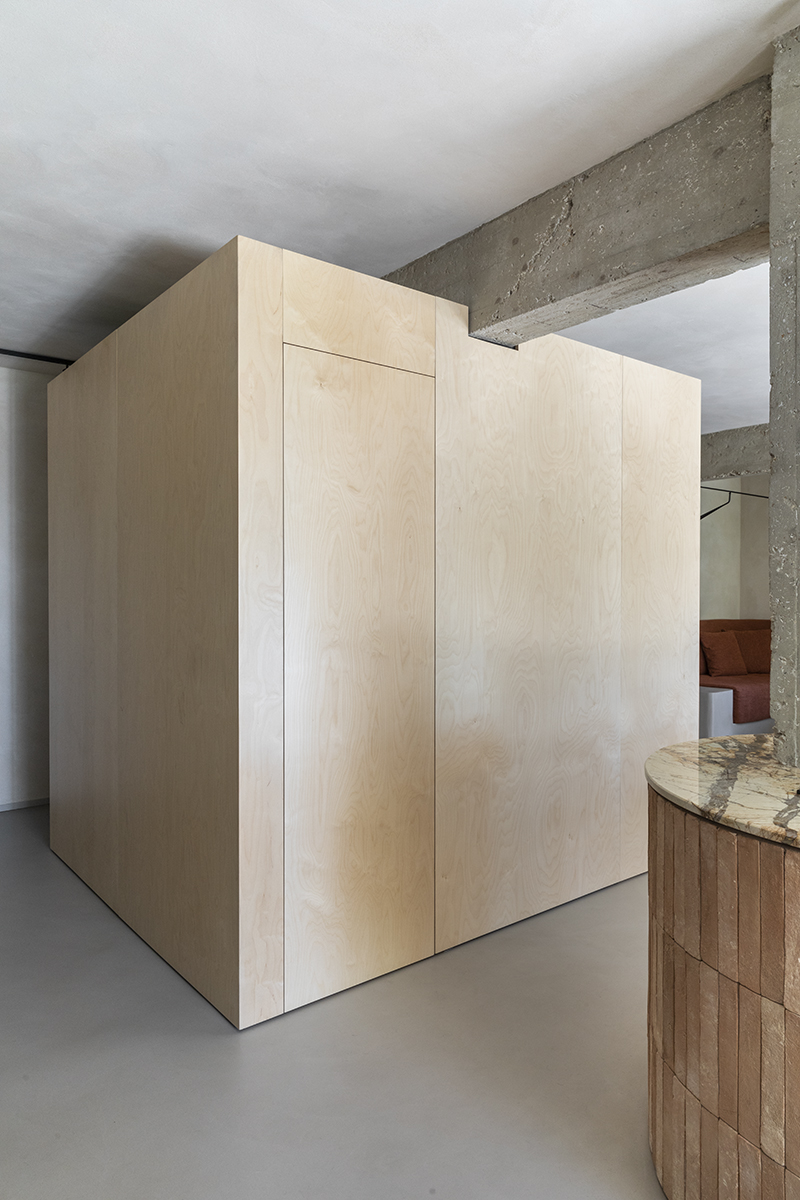
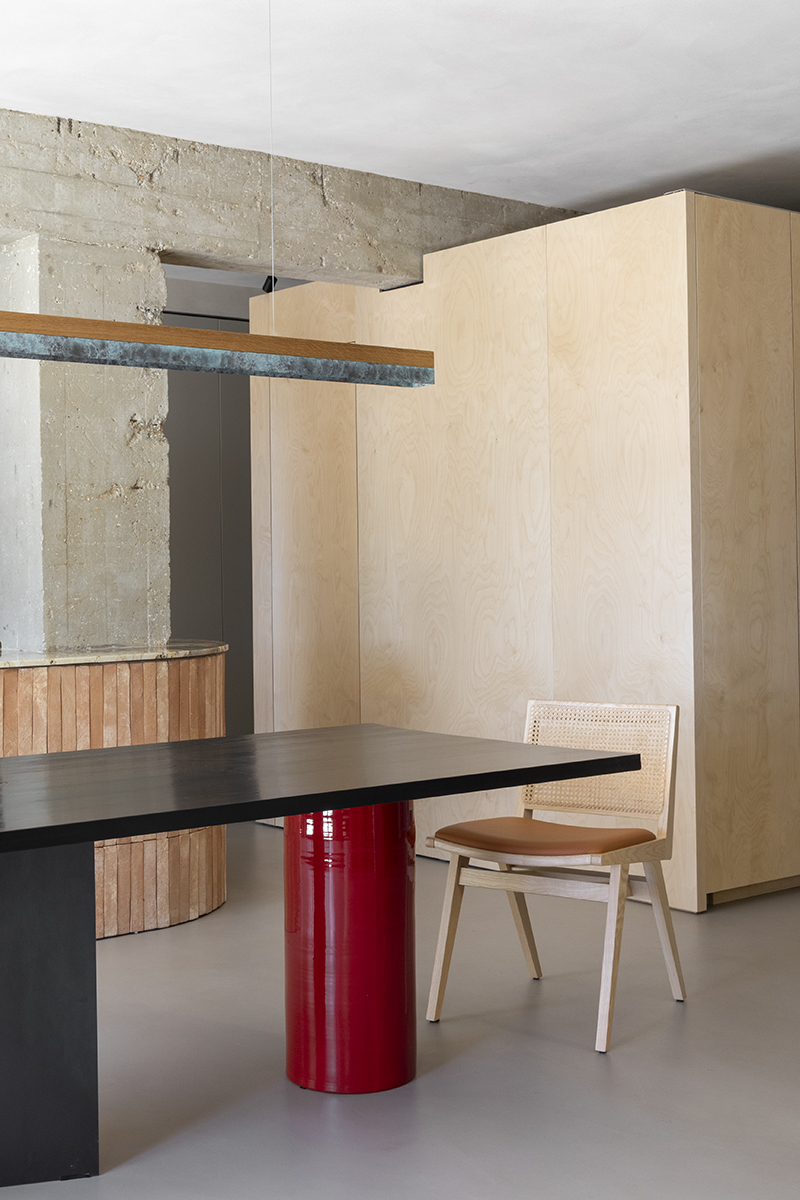
The sartorial work done on the interiors extends to the custom-made furnishings. The dining table has a solid wood top burned using the Japanese Shou sugi technique and it is supported by a cylindrical ceramic leg and two raw iron sheets; the studio desk moves in space thanks to a wooden wheel that runs on a track hidden inside the bookcase; the masonry sofa is cut considering the physicality of the owners; the kitchen with the island entirely covered in terracotta and Patagonia marble worktop incorporates two reinforced concrete pillars inside.
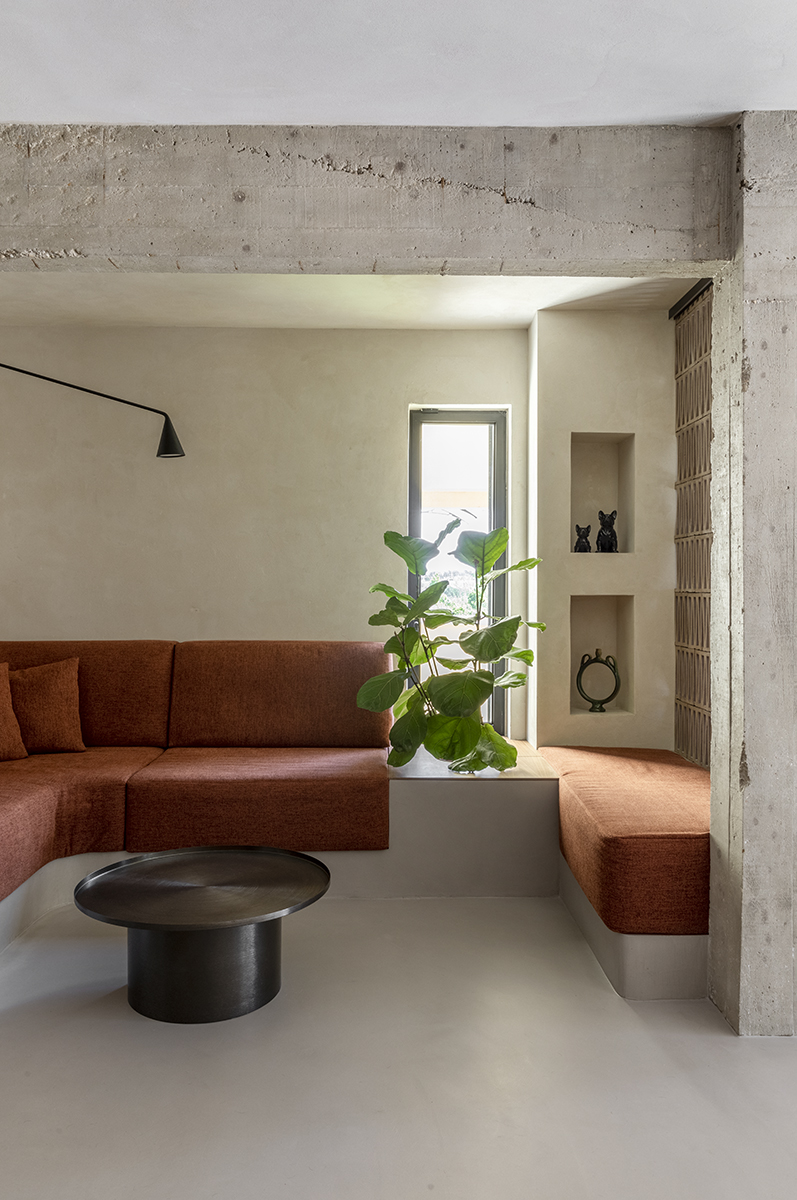
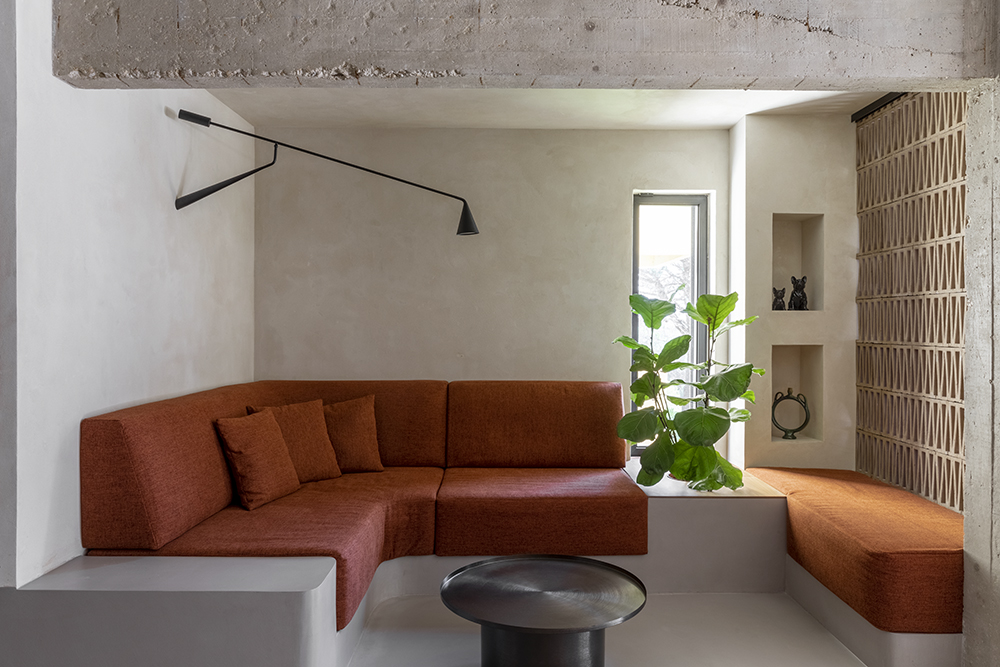
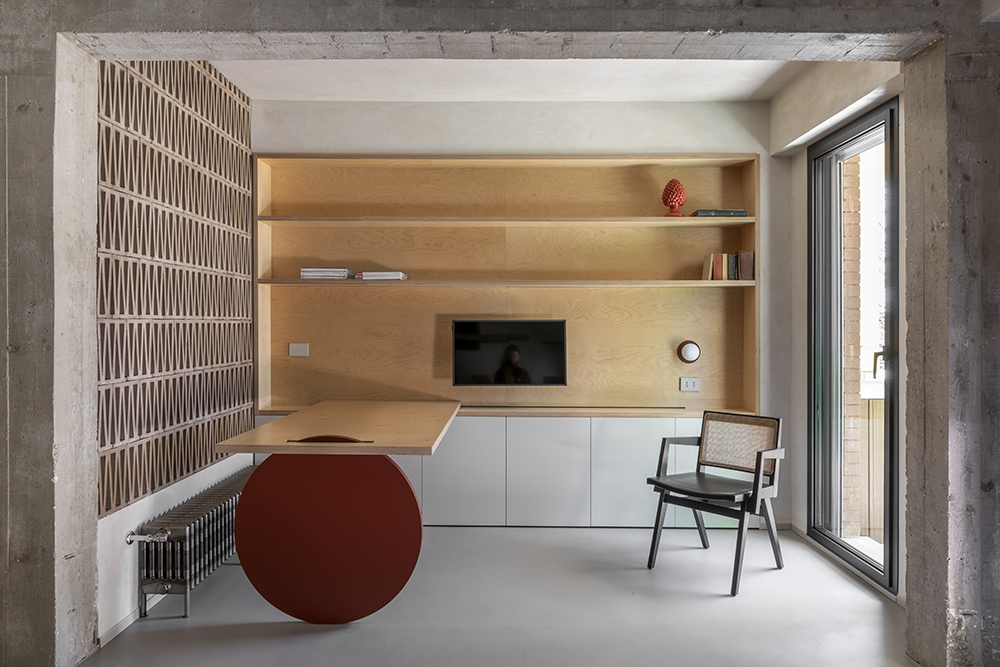
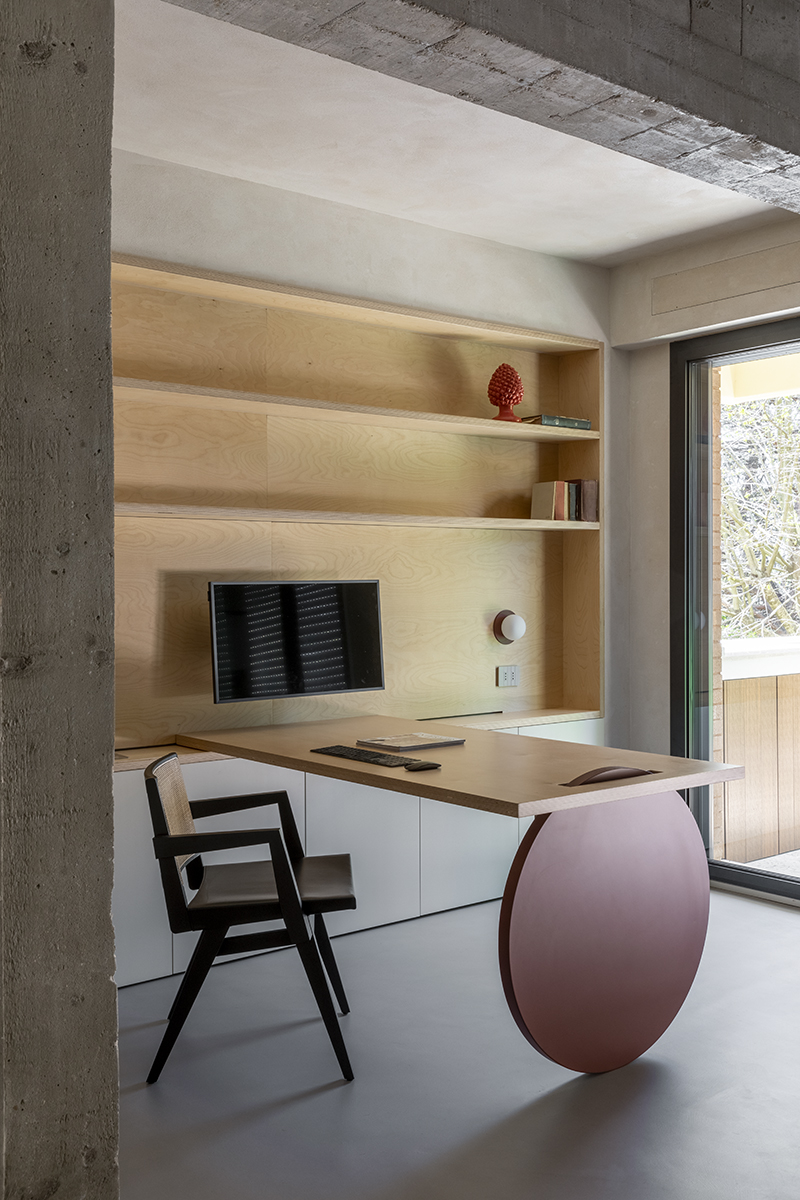 A clear break separates the sleeping area: a pivot door in perforated sheet metal partially screens the corridor, which connects the guest bedroom and the master bedroom with en-suite bathroom, to the main bathroom with tub and the walk-in closet.
A clear break separates the sleeping area: a pivot door in perforated sheet metal partially screens the corridor, which connects the guest bedroom and the master bedroom with en-suite bathroom, to the main bathroom with tub and the walk-in closet.
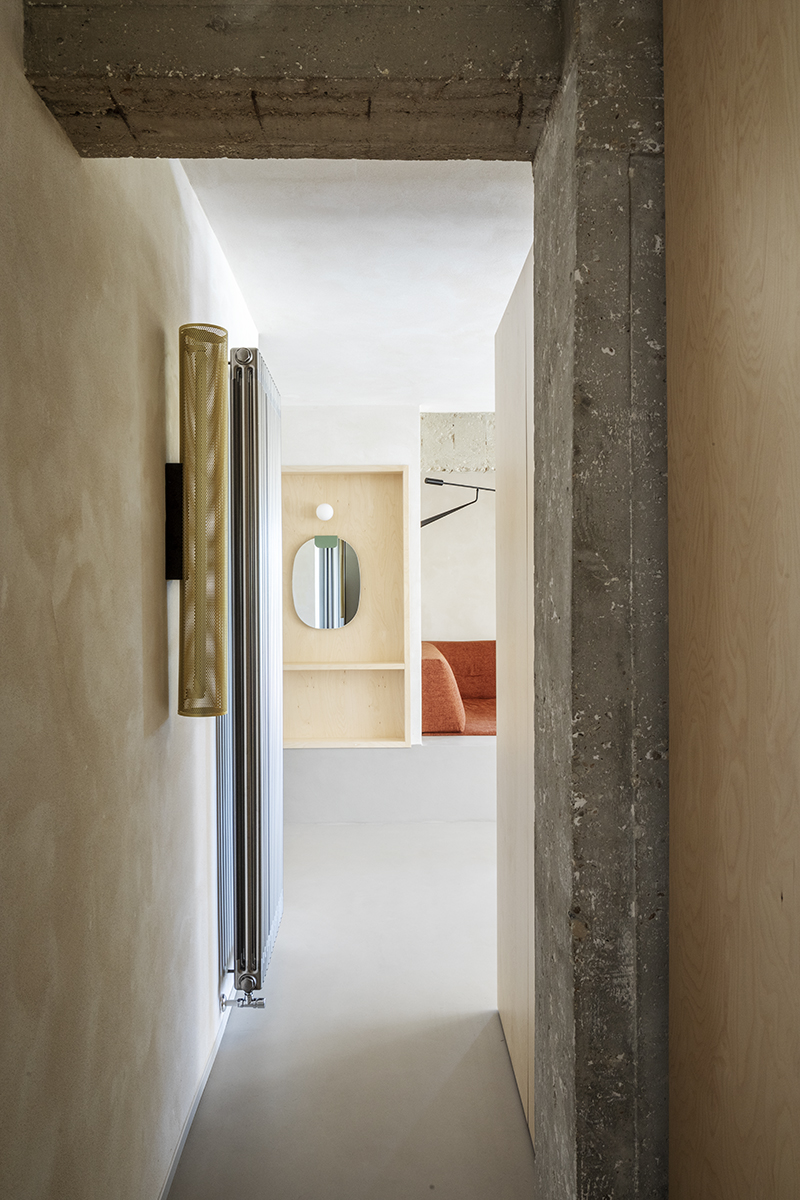
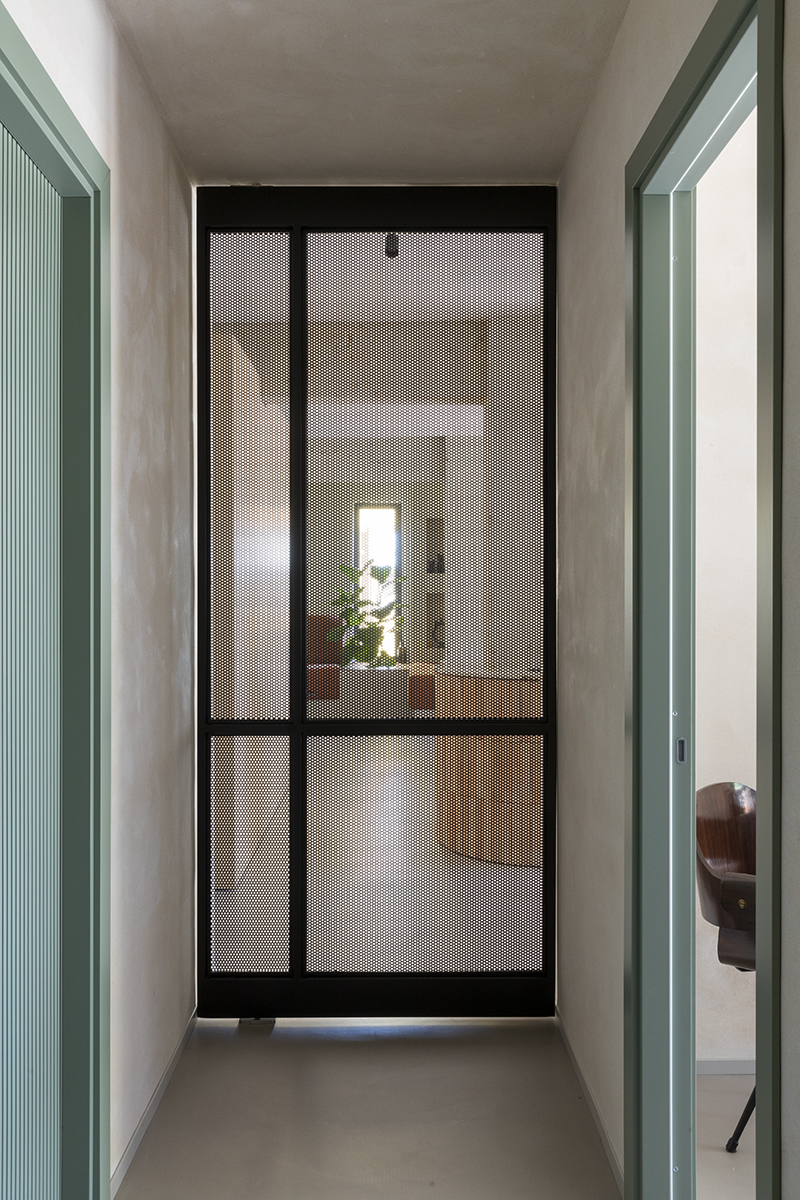
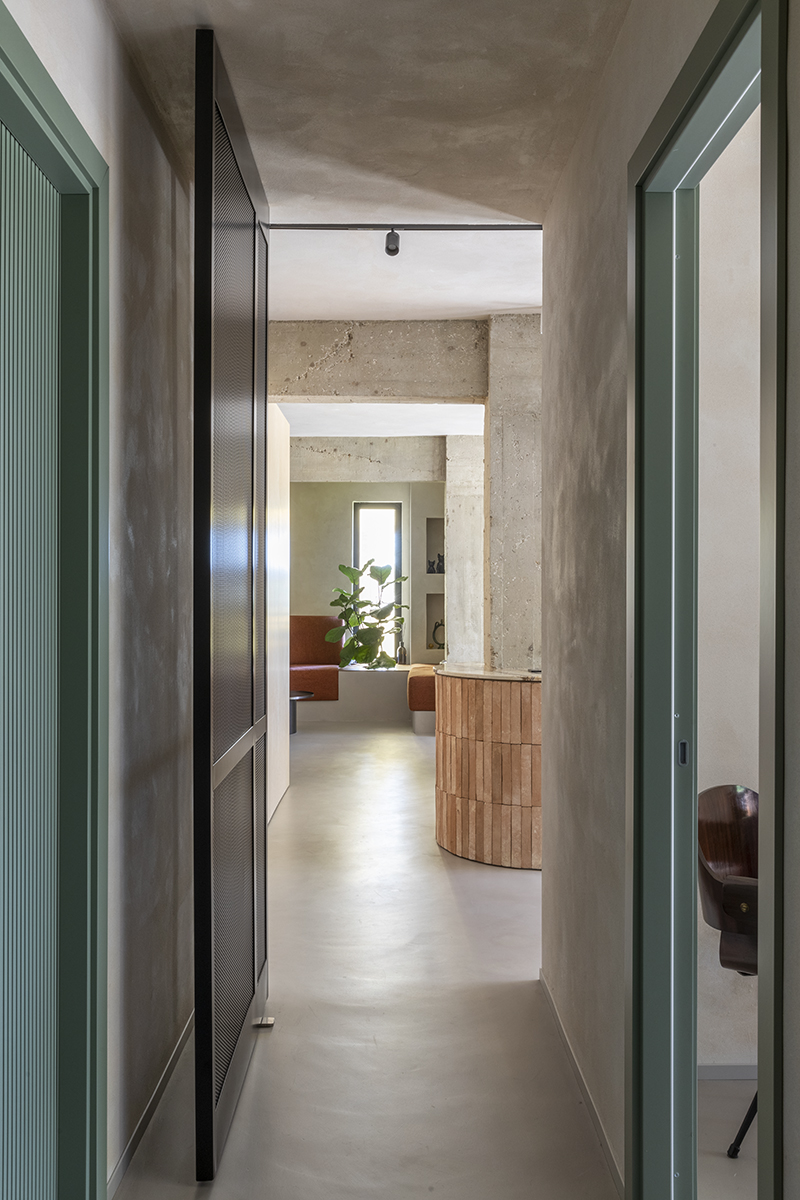
The transition is also marked by the change of flooring, from the resin that prevails in the living area, to the terracotta of the more private areas.
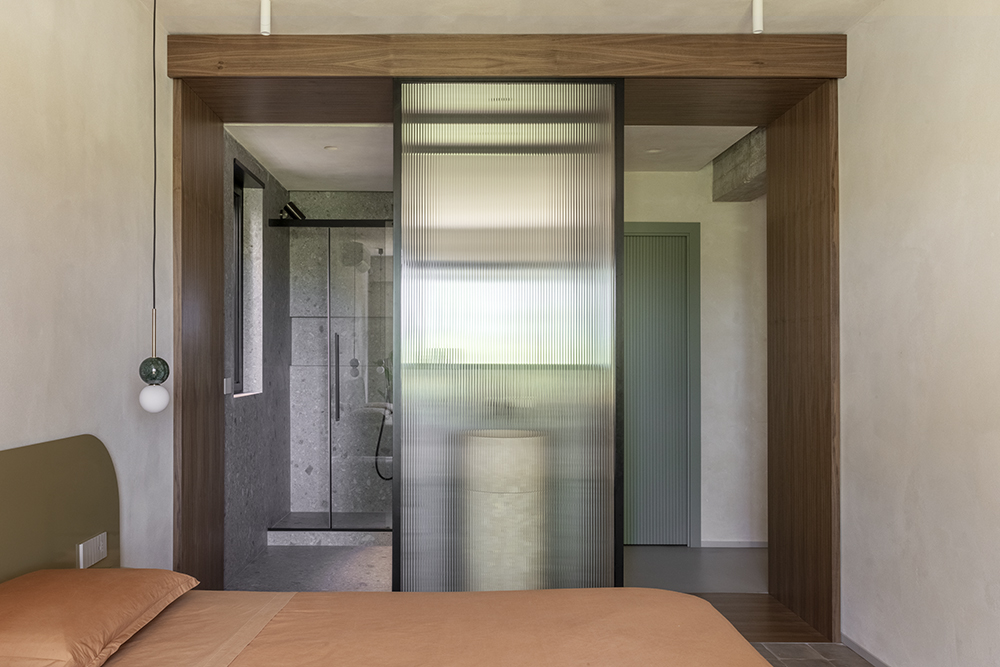
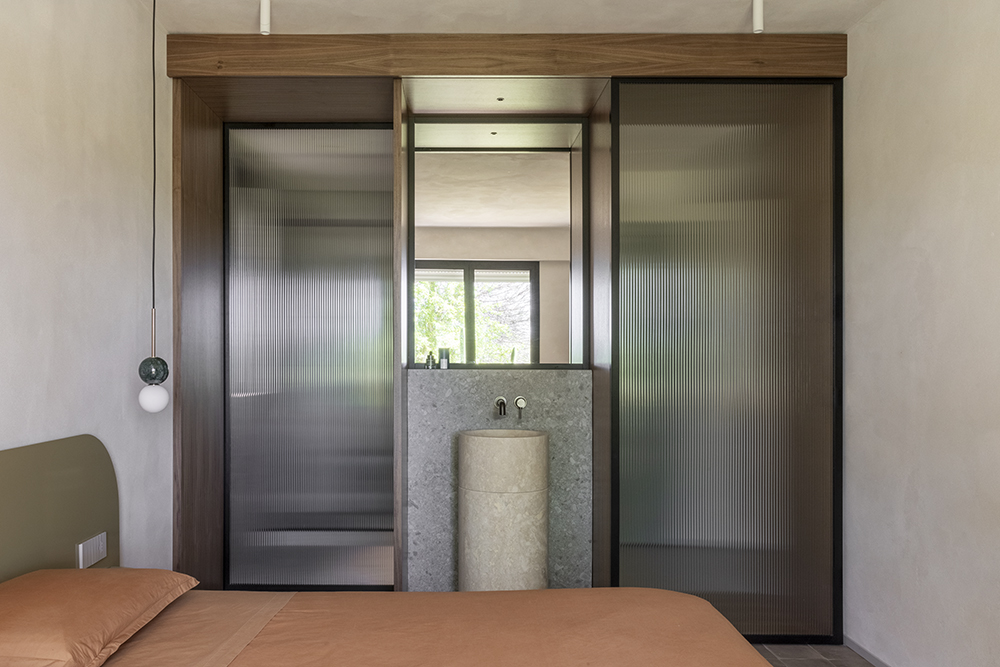
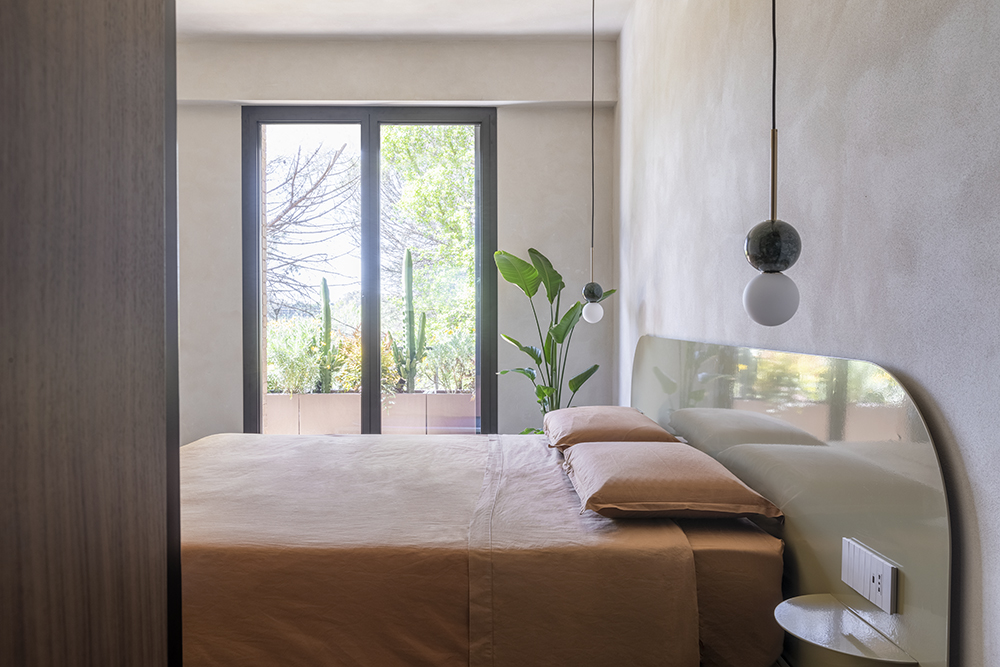
The master bedroom has an equipped wall in walnut wood, which acts as a filter. Inside, in fact, it houses two ribbed glass doors which allow, if necessary, to annex the bathroom to the room, or to leave as pertinent only the compartment containing the freestanding sink.
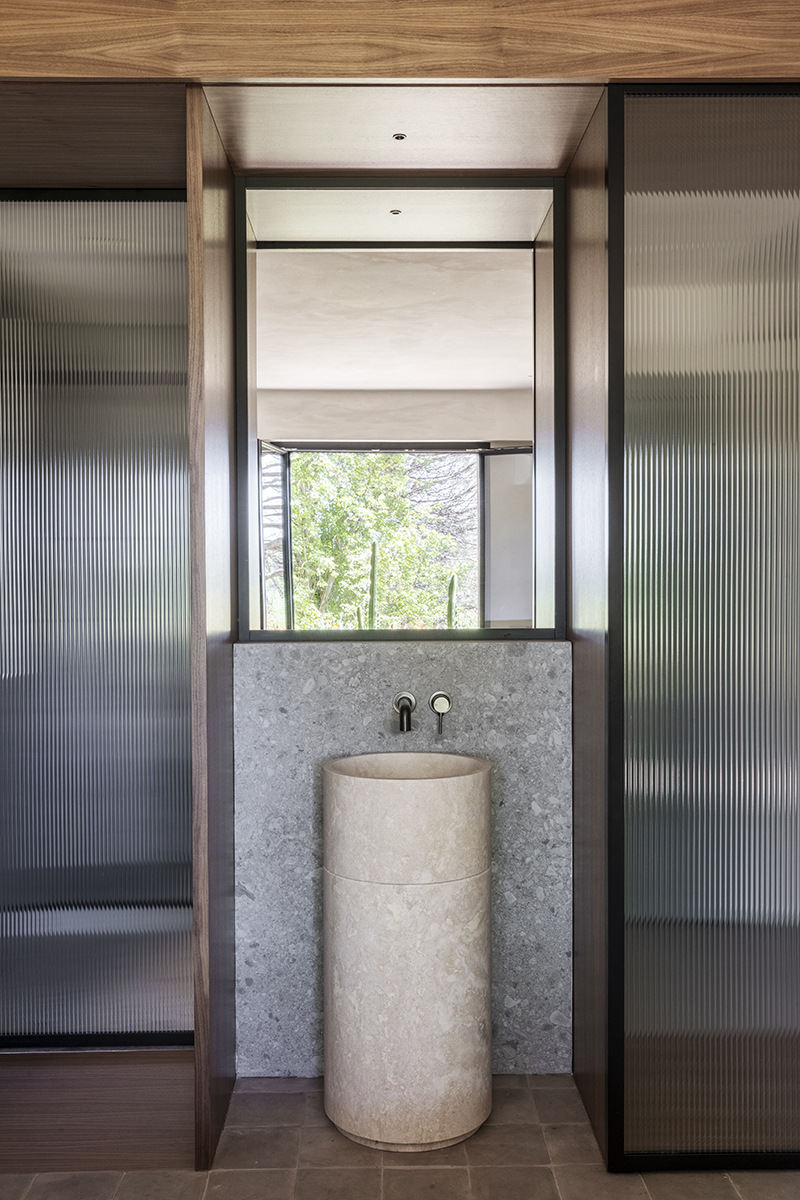
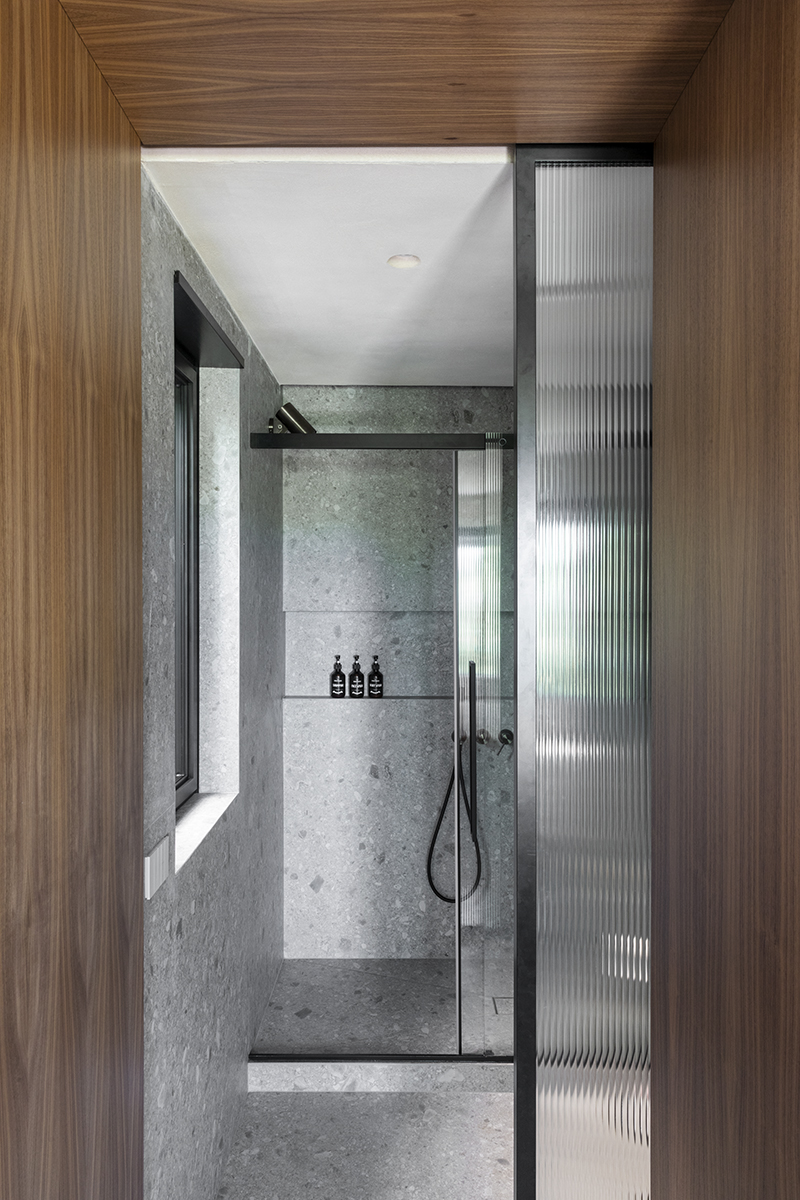
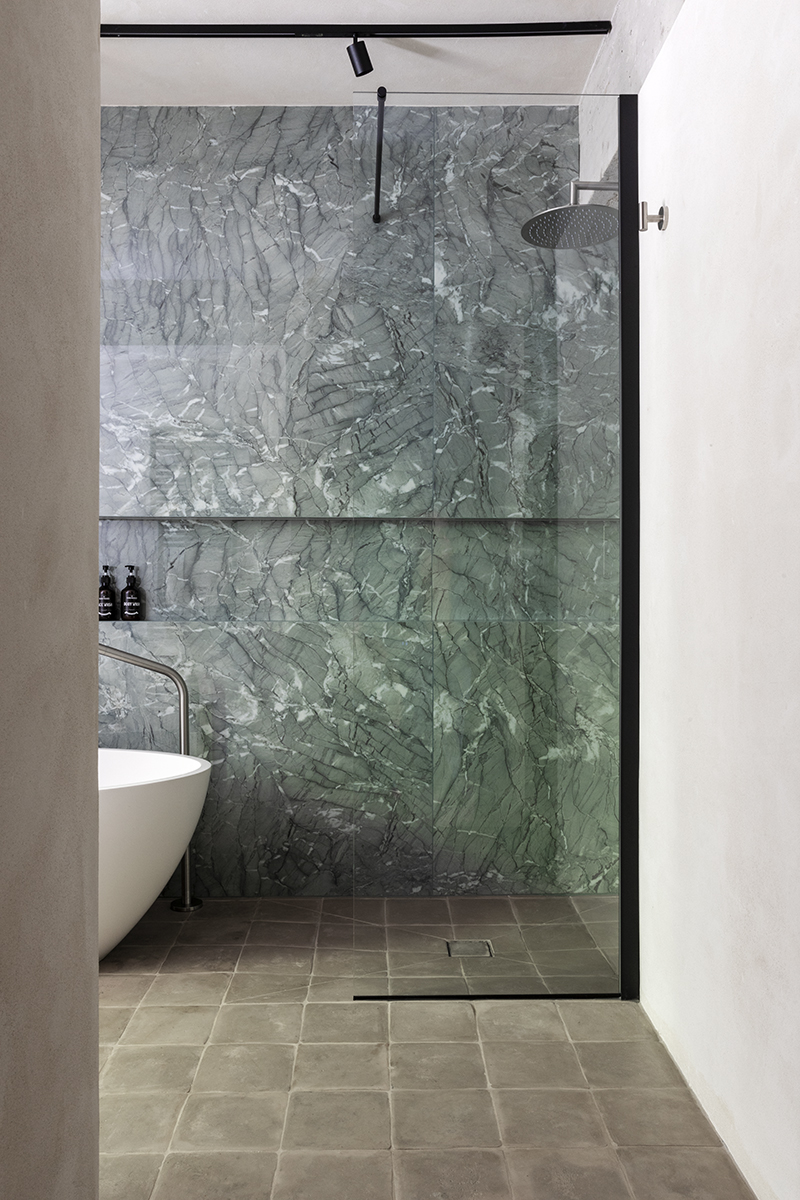
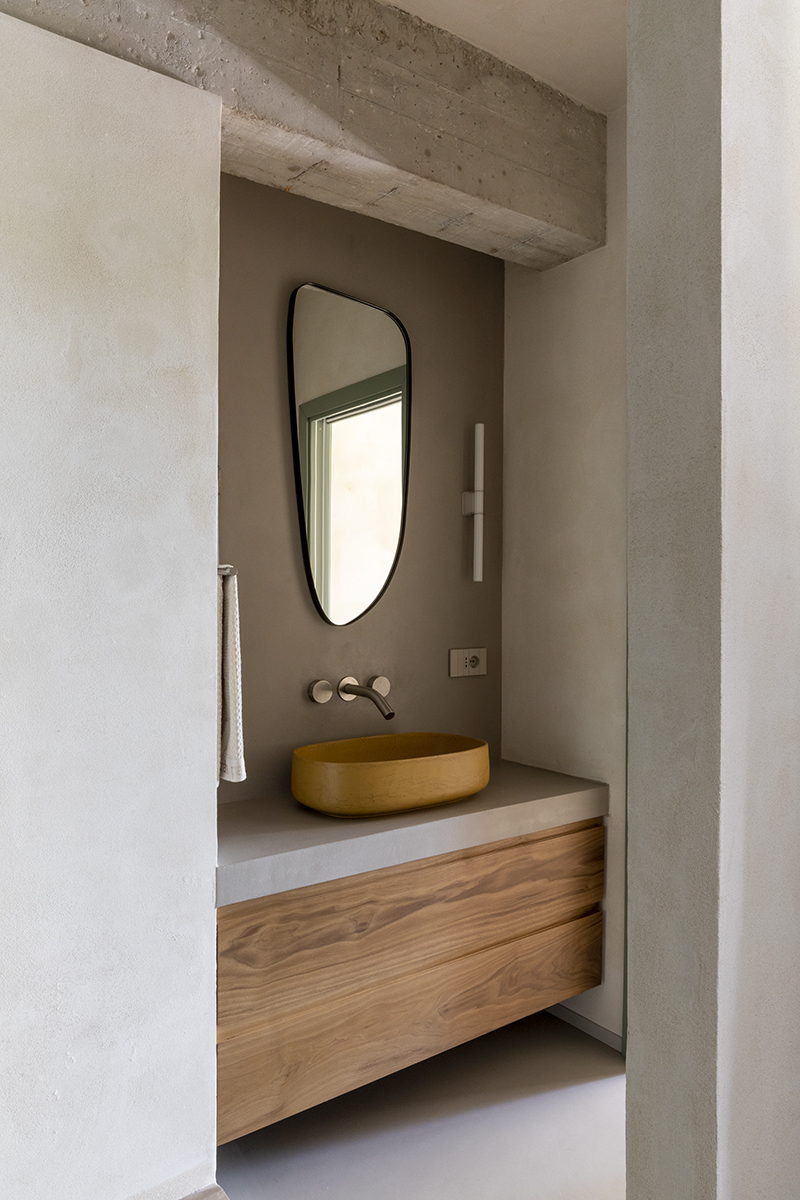 The terrace extends along the entire south-west side of the apartment, offering breathtaking sunsets. The external masonry kitchen, covered in travertine, taking up the pre-existing thresholds, is integrated into the parapet and the bench, which serves as a seat for the dining table, while the horizontal surface is covered in wooden slats. A brise soleil shields the technical area of the systems and acts as a backdrop for the outdoor shower with direct access to the bedroom, blurring the boundary between inside and outside.
The terrace extends along the entire south-west side of the apartment, offering breathtaking sunsets. The external masonry kitchen, covered in travertine, taking up the pre-existing thresholds, is integrated into the parapet and the bench, which serves as a seat for the dining table, while the horizontal surface is covered in wooden slats. A brise soleil shields the technical area of the systems and acts as a backdrop for the outdoor shower with direct access to the bedroom, blurring the boundary between inside and outside.
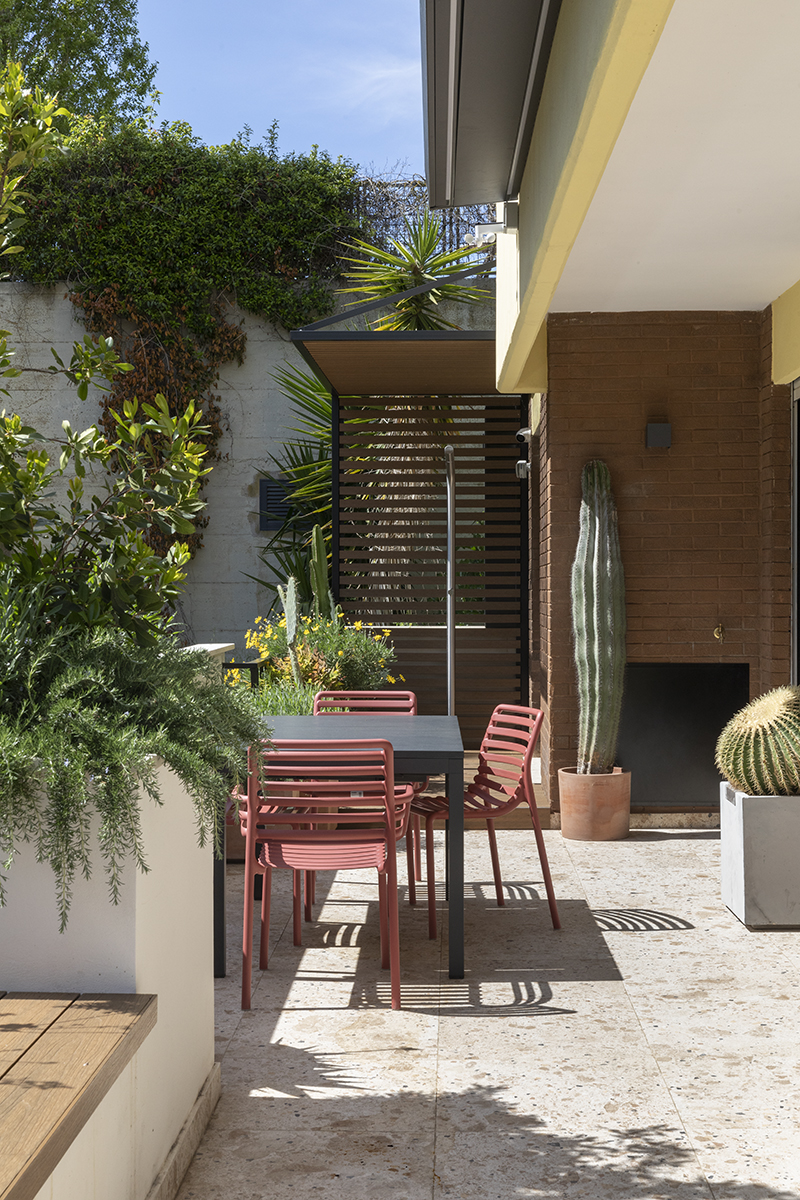
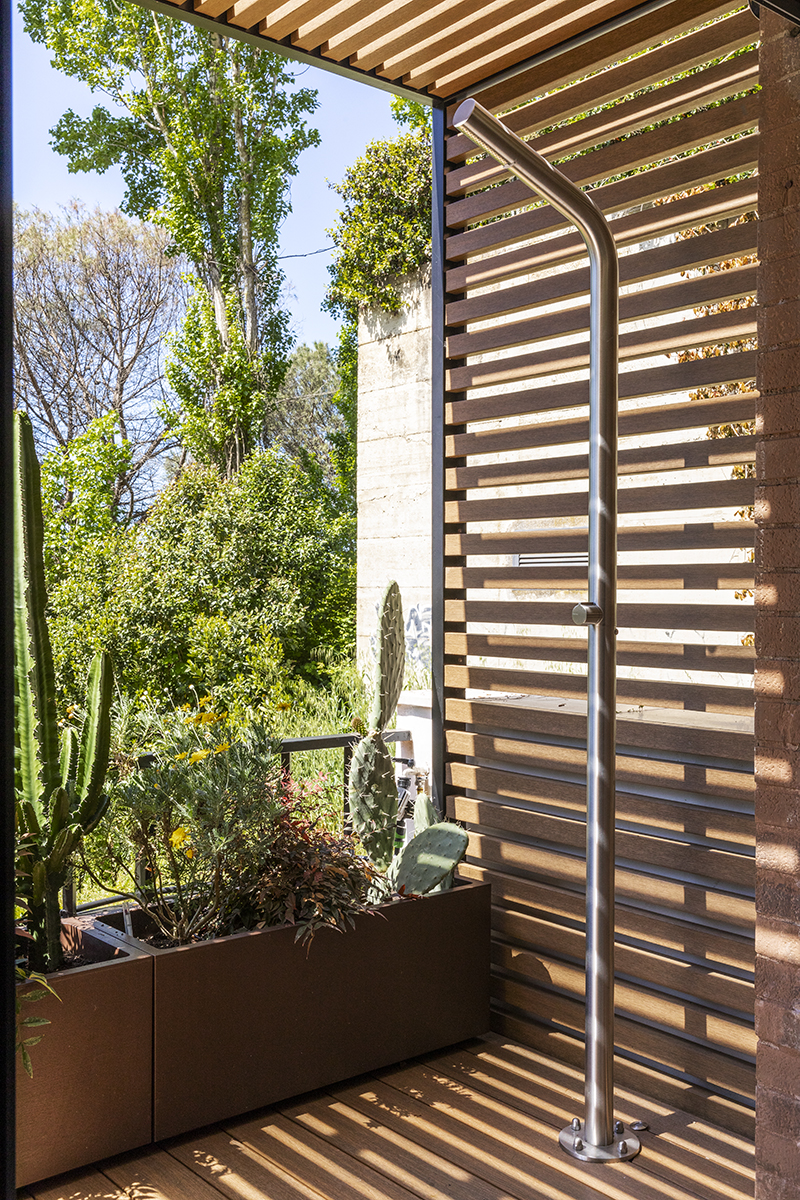
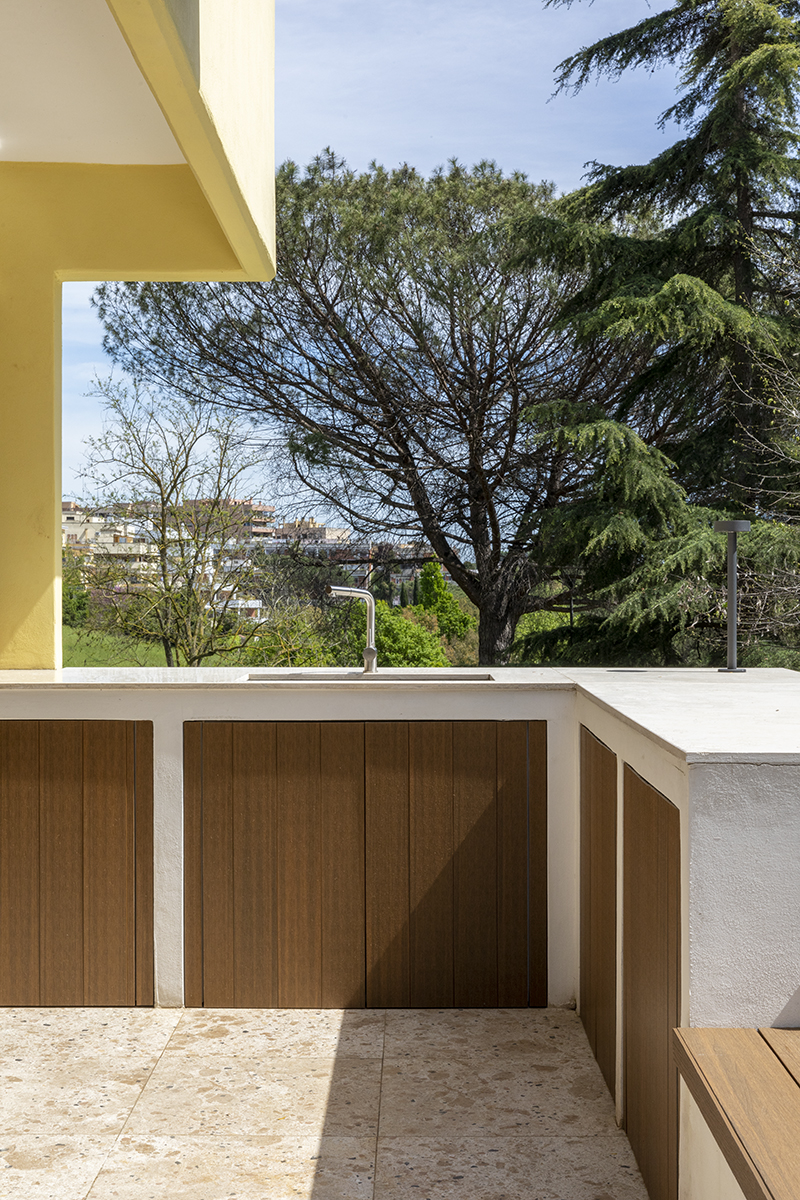 Mixing softness and brutalism, contemporary accents and tailor-made interventions, the STUDIOTAMAT-designed apartment is an oasis of serenity where you can take a break from the frenetic pace of the city.
Mixing softness and brutalism, contemporary accents and tailor-made interventions, the STUDIOTAMAT-designed apartment is an oasis of serenity where you can take a break from the frenetic pace of the city.
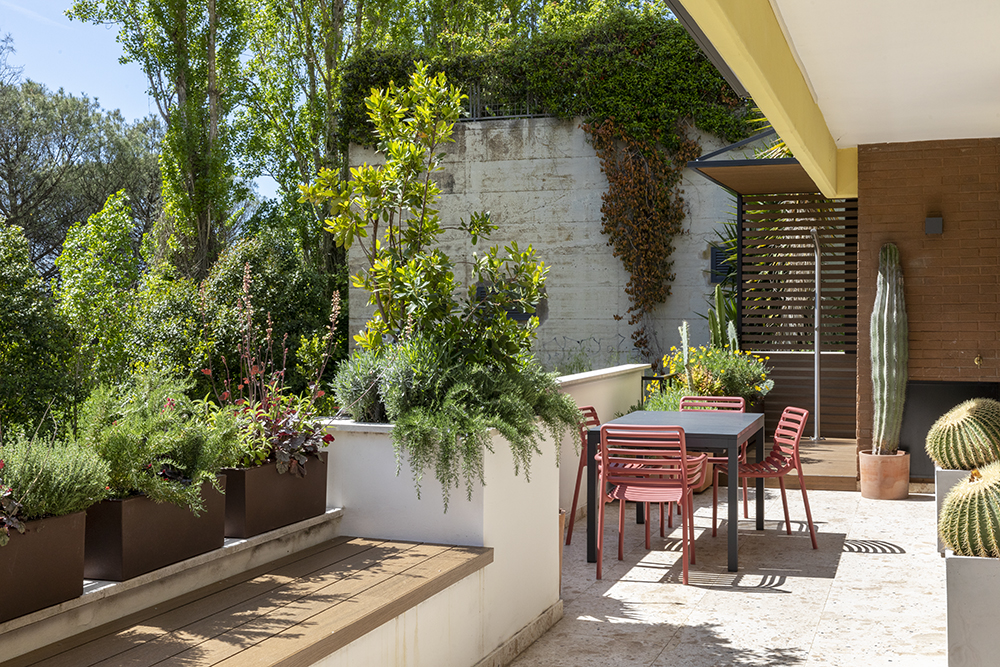
Credits & Details
Project: Casa Rude
Address: Tor De Cenci, Rome
Architect: STUDIOTAMAT (Tommaso Amato, Matteo Soddu and Valentina Paiola)
Project team: Tommaso Amato, Matteo Soddu and Valentina Paiola Silvia D’Alessandro, Alice Patrizi
Lighting designer: Fabio Silvestris
Client: Private
Dates: May 2023
GFA: 120 sqm + 40 sqm (terrace)
Contractor: Ciquattro Servizi Edili Srl
Photographer: ©Serena Eller Vainicher
READ ALSO: Igesa_Conversion of a former military clinic into secured offices | by Boman Architects